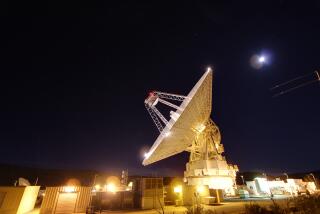U.S. missile defense system is ‘simply unable to protect the public,’ report says
- Share via
Reporting from Washington — The system designed to defend American cities and towns against a nuclear attack by North Korea is “simply unable to protect the U.S. public” and will remain ineffective unless Congress exerts rigorous oversight, according to a new report.
The report, to be released Thursday by the Union of Concerned Scientists, recommends that the Obama administration halt the expansion of the Ground-based Midcourse Defense system, known as GMD, until its technical problems have been solved.
“The story of this system is a cautionary tale about how the lack of appropriate oversight of a politically charged missile defense program has led to a system in tatters,” said the report, written by three physicists with expertise in missile defense.
“Despite more than a decade of development and a bill of $40 billion, the GMD system is simply unable to protect the U.S. public,’’ the authors wrote.
The GMD system is intended to thwart a “limited” nuclear strike by a non-superpower adversary, such as North Korea or Iran.
In the event of an attack, rocket interceptors at Vandenberg Air Force Base in Santa Barbara County and Ft. Greely, Alaska, would be launched from underground silos. Once in space, the interceptors would separate from their booster rockets and attempt to slam into and “kill” enemy warheads.
The report notes that in “heavily scripted” flight tests that are “set up for success,” GMD interceptors have often failed to hit mock enemy warheads. In the seven most recent tests, interceptors destroyed their targets just three times, the report says -- a finding consistent with conclusions of the Pentagon’s operational test and evaluation office.
Personnel conducting the tests know the speed, location and trajectory of the target ahead of time, as well as when it will be launched – information they would not have in a real attack.
The report relies extensively on articles published over the last two years by the Los Angeles Times, along with a National Academy of Sciences report and the findings of federal auditors and the Pentagon test office.
The report said members of Congress and Pentagon officials insisted on deploying and expanding the system at a rapid pace—at the expense of sound procurement and engineering.
“Repeatedly,” the report said, “the Pentagon has sacrificed quality, shortened engineering cycles and sidestepped acquisitions best practices to meet a deadline imposed by political rationales rather than technical realities.”
Pentagon officials have also made “unsubstantiated claims about the system’s effectiveness,” the report says, calling this “both cynical and a disservice to the public.’’
The Pentagon has sacrificed quality ... to meet a deadline imposed by political rationales rather than technical realities.
— Union of Concerned Scientists report
The finding dovetails with a July 6 Times article about a GMD flight test held in January. The Times revealed that a crucial component stopped working during the test, causing an interceptor to fly far off course. The U.S. Missile Defense Agency and two of its lead contractors nevertheless issued news releases that pronounced the test a success, with no mention of the malfunction.
Asked for comment on the report, agency spokesman Chris Johnson said the National Missile Defense Act of 1999 called for deploying an effective system “as soon as was technologically possible.”
He added: “This rapid deployment was a driving factor in delivering a ground-based interceptor capability with reliability challenges.” The agency is trying to make the system more reliable while staying “on track” to expand the fleet of interceptors, Johnson said.
The Union of Concerned Scientists was formed in 1969 by students and faculty at MIT to resist what they saw as the government’s misuse of science and technology for military aims.
In the 1980s, the group opposed President Reagan’s Strategic Defense Initiative, the proposed space-based anti-missile system known as “Star Wars.” No such system was ever deployed, but efforts to create a missile shield continued. The GMD system was one of the results.
The report’s lead author is Laura Grego, a Caltech-trained physicist who is a senior scientist at the Union of Concerned Scientists. The coauthors are physicists David Wright, also with the group, and George N. Lewis, a visiting scholar at Cornell University who gained attention for challenging the claimed success rate of rockets launched by Israel to intercept Iraqi missiles during the 1991 Persian Gulf War.
The 60-page report, “Shielded from Oversight: The Disastrous U.S. Approach to Strategic Missile Defense,” traces GMD’s problems to President George W. Bush’s decision to make the system operational in 2004 before the highly complex interceptors had been adequately tested.
The report said that the Obama administration “has continued a similarly lax approach to missile defense.”
For instance, the administration has kept in place Bush’s decision exempting the Missile Defense Agency from standard Defense Department acquisition and testing procedures.
With bipartisan support in Congress, Obama has directed the agency to expand the GMD fleet—despite its technical shortcomings—from the present 30 interceptors to a total of 44 by the end of next year.
“Congress and the administration should halt the deployment of additional interceptors until all known flaws have been eliminated from those additional interceptors and a testing program shows they are effective and reliable,” the report says.
The physicists write that “the continued development of the GMD system without adequate oversight and accountability, and the continued fielding of interceptors without adequate testing, means the system is not even on a path to achieving a useful ability to intercept ballistic missiles.”
Boeing Co. is the Pentagon’s prime contractor for GMD. The interceptors are built by Raytheon Co. The component that malfunctioned during the January flight test, called a divert thruster, is manufactured by Aerojet Rocketdyne Inc.
Twitter: @dwillmannews
MORE ON MISSILE DEFENSE
$40-billion missile defense system proves unreliable
Pentagon skips tests on key component of U.S.-based missile defense system
More to Read
Sign up for Essential California
The most important California stories and recommendations in your inbox every morning.
You may occasionally receive promotional content from the Los Angeles Times.











